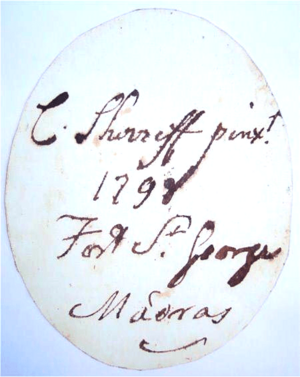Charles Shirreff (painter) facts for kids
Quick facts for kids
Charles Shirreff
|
|
|---|---|

Shirreff's signature on the reverse of a 1798 miniature
|
|
| Born | c.1750 Edinburgh, Scotland
|
| Died | 1829 (aged 78–79) London, U.K.
|
| Nationality | Scottish |
| Education | Royal Academy of Art |
| Known for | Painting, portrait miniatures |
Charles Shirreff (around 1750–1829) was a Scottish painter. He was deaf and specialized in painting very small portraits. These tiny artworks are called portrait miniatures.
Early Life and Learning
Charles Shirreff was born in Scotland, around 1749 or 1750. His father, Alexander Shirreff, was a rich wine merchant.
When Charles was about three or four years old, he became deaf and could not speak. In 1760, his father looked for a school for him. He found Thomas Braidwood, who ran a math school in Edinburgh.
Charles became Braidwood's first deaf student. Soon after, Braidwood started the first school for deaf people in Britain. It was called Braidwood's Academy for the Deaf and Dumb.
At 18, in 1769, Charles left Braidwood's Academy. He went to London to study art at the Royal Academy Schools. He finished his studies in 1772 and won a silver medal. After that, he became a professional miniaturist.
Becoming a Professional Artist

Besides miniatures, Charles Shirreff also created drawings using pastels. He showed his oil paintings, pastels, and pencil drawings at important art shows. These included the Royal Academy of Arts and the Free Society of Artists.
Shirreff worked in London after art school. Many of his clients were people from the theater world. He became friends with Caleb Whitefoord, a well-known Scottish merchant. Through Whitefoord, Shirreff met other famous portrait painters.
Sadly, Charles's father lost all his money in 1772. Charles then used his art to support his family. In 1778, he wanted to go to India to work. He told the East India Company that he was deaf but could communicate using signs. He asked if his father and sister Mary could go with him to help interpret. However, his trip to India was put on hold. He stayed in England for another 20 years.
Shirreff also taught miniature painting. One of his students was Archibald Robertson, another Scottish miniaturist.
Charles Shirreff lived and worked in Bath for several years. During this time, he painted portraits for many people. One famous person he painted was the actress Sarah Siddons. She said his portrait of her was better than any other miniature she had posed for. In Bath, he shared clients with two other deaf miniaturists, Sampson Towgood Roch and Richard Crosse.

In 1795, he decided to try again to go to India. He left England and arrived in Madras in 1797. He painted in Madras for some years. Then he moved to Calcutta. There, he worked on a special project called Illustrations of Signs. In 1807, he announced it was almost finished. Sadly, this important work has never been found and is believed to be lost.
He returned from India around 1808 or 1809. He settled back in London and continued his painting career.
Charles Shirreff died in 1829. Official records show that his will was approved in court in November 1829. This means he must have passed away before that date.
Personal Life
On January 11, 1810, Charles Shirreff married Mary Ann Brown. She was the sister of another artist. They got married at St George's, Hanover Square in London.
The couple lived in London, first in Fitzroy Square and later in Connaught Square. They stayed there until Charles passed away.

